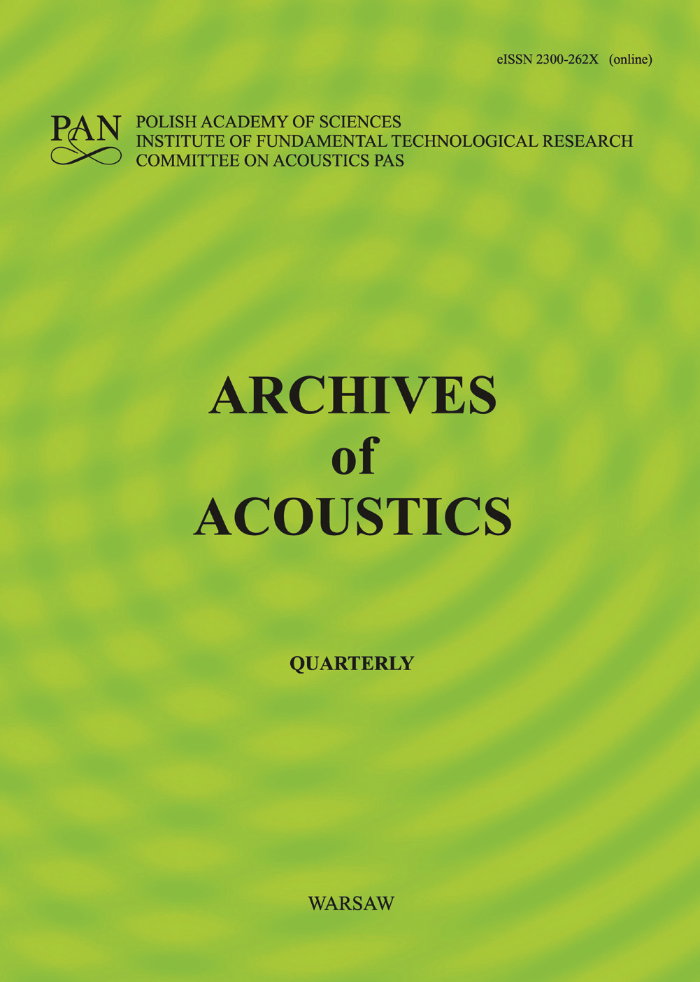A Hybrid Method for Predicting the Bistatic Target Strength Based on the Monostatic Scattering Sound Pressure Data
Abstract
To predict the scattered acoustic field for underwater targets with separate transmission and reception points, a forecasting method based on limited scattered acoustic pressure data is proposed. This method represents the scattered acoustic field as the product of n acoustic scattering transfer function and a source density function. By performing numerical integration, the transfer function is obtained using the model surface grid information as input. An equation system concerning the unknown source density function is then derived using the computed scattering transfer matrix, the principle of acoustic reciprocity, and the geometric properties of the target. The unknown source density function is solved using the least squares method. The scattered field with separate transmission and reception points is then obtained by multiplying the calculated transfer matrix with the estimated source density function. This paper applies the finite element method (FEM) to solve the scattering field for a benchmark model with separate transmission and reception points. Using a subset of the elements as input, predictions of the omnidirectional scattered field were made. The predicted results were subsequently compared with those obtained from FEM simulations. The simulation results demonstrate that the proposed method maintains high computational accuracy and is applicable to the prediction of low-frequency scattered fields from underwater targets with spatially separated source and receiver. Further comparison with the FEM-calculated target strength patterns across varying incident–reception angles reveals a high level of agreement, indicating that accurate bistatic target strength predictions can be achieved with a limited amount of input data.
Keywords:
acoustic scattering properties, bistatic scattering sound field, scattering sound field prediction, target strengthReferences
- Agounad S., Decultot D., Chati F., Leon F., Khandouch Y. (2023), Experimental study of the bistatic acoustic scattering from cylindrical shell, Mechanical Systems and Signal Processing, 186: 109892, https://doi.org/10.1016/j.ymssp.2022.109892.
- Chen C.X., Peng Z.L., Song H., Xue Y.Q., Zhou F.L. (2024), Prediction method of the low-frequency multistatic scattering sound field for underwater spherical targets based on limited data [in Chinese], Journal of Shanghai Jiaotong University, 58(7): 1006–1017.
- Cheng G., Zhang M., Du K., Yao W. (2010), Model and experiments for bistatic scattering strength of underwater objects, [in:] 2010 International Conference on Computer Application and System Modeling (ICCASM 2010), 9: V9-489-V9-492, https://doi.org/10.1109/ICCASM.2010.5622985.
- Fan J., Zhou L.K. (2006), Graphical acoustics computing method for echo characteristics calculation of underwater targets [in Chinese], Acta Acustica, 31(6): 511–516.
- Gu R., Peng Z., Xue Y., Xu C., Chen C. (2025), An improved fast prediction method for full-space bistatic acoustic scattering of underwater vehicles, Sensors, 25(8): 2612, https://doi.org/10.3390/s25082612.
- Gunderson A.M., Espana A.L., Marston P.L. (2017), Spectral analysis of bistatic scattering from underwater elastic cylinders and spheres, The Journal of the Acoustical Society of America, 142(1): 110–115, https://doi.org/10.1121/1.4990690.
- Liu Y.C., Zhang M.M., Wang Y.L. (2012), Calculation of target bistatic acoustic scattering using physical acoustic method [in Chinese], Journal of Naval University of Engineering, 24(4): 101–103.
- Long L.Y, Zhao H.S, Li D. (2022), Analysis of array configuration design for multi-base sonar buoy systems, Acoustics and Electronics Engineering, 2022(1): 6–9.
- Meng Z.R., Song Y., Yu F.X., Zhang C.L., Zhang Y.Q. (2024), Highlight model of underwater target acoustic scattering in the bistatic system, Journal of Computers, 35(2): 231–249, http://doi.org/10.53106/199115992024043502015.
- Park S.H. et al. (2006), Bistatic scattering from a hemi-spherically capped cylinder, The Journal of the Acoustical Society of Korea, 25(3E): 115–122.
- Peng Z.L., Wang B., Fan J. (2018), Simulation and experimental studies on acoustic scattering characteristics of surface targets, Applied Acoustics, 137: 140–147, https://doi.org/10.1016/j.apacoust.2018.02.014.
- Schenck H.A., Benthien G.W., Barach D. (1995), A hybrid method for predicting the complete scattering function from limited data, The Journal of the Acoustical Society of America, 98(6): 3469–3481, https://doi.org/10.1121/1.413779.
- Schmidt H. (2001), Bistatic scattering from buried targets in shallow water, [in:] Proceedings, GOATS 2000 Conference, La Spezia, 2001: 21–22.
- Schneider J.B., Wagner C.L., Broschat S.L. (1998), Implementation of transparent sources embedded in acoustic finite-difference time-domain grids, The Journal of the Acoustical Society of America, 103(1): 136–142, https://doi.org/10.1121/1.421084.
- Tang W.L., Fan J., Ma Z.C. (2018), Acoustic Scattering of Underwater Targets [in Chinese], Beijing: Science Press.
- Wang B., Wang W.H., Fan J., Zhao K.Q., Zhou F.L., Tan L.W. (2022), Modeling of bistatic scattering from an underwater non-penetrable target using a Kirchhoff approximation method, Defence Technology, 18(7): 1097–1106, https://doi.org/10.1016/j.dt.2022.04.008.
- Waterman P.C. (2005), New formulation of acoustic scattering, The Journal of the Acoustical Society of America, 45(6): 1417–1429, https://doi.org/10.1121/1.1911619.
- Xue Y.Q., Peng Z.L., Yu Q., Zhang C., Zhou F., Liu J. (2023), Analysis of acoustic scattering characteristics of underwater targets based on Kirchhoff approximation and curved triangular mesh [in Chinese], Acta Armamentarii, 44(8): 2424–2431.
- Zhang L.L., Yang R.J., Yang C.Y. (2011), Research on underwater maneuvering target tracking technology [in Chinese], Technical Acoustics, 30(1): 68–73, https://doi.org/10.3969/j.issn1000-3630.2011.01.012.
- Zhou L.K, Fan J., Tang W.L. (2009), Analyzing acoustic scattering of elastic objects using coupled FEM-BEM technique [in Chinese], Journal of Shanghai Jiaotong University, 43(8): 1258–1261.







